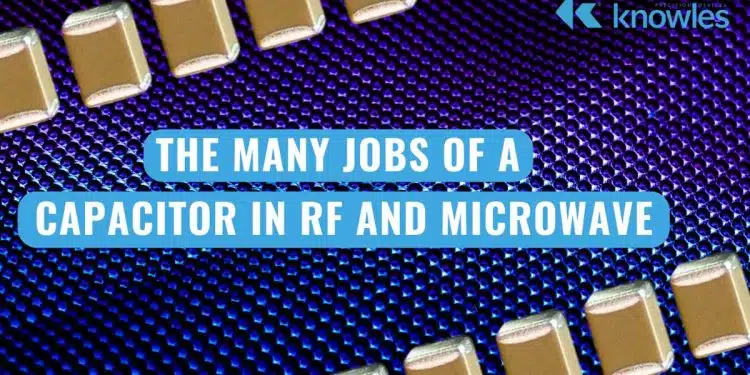This article based on Knowles Precision Devices blog explains applications and function of capacitors in RF and Microwave circuits.
Radio frequency (RF) and microwave applications involve transmitting and receiving electromagnetic signals at high frequencies. While these terms are often used interchangeably, RF means AC signals at 3 kHz to 300 GHz. For microwave, it’s more like 300 MHz to 300 GHz. Capacitors play a central role in these applications because they are concerned with capacitance, naturally, and impedance (i.e., resistance), which vary with frequency. Functionally, these passive electronic components store energy in an electric field.
With many options for configurations and applications, capacitors support a variety of functions in RF and microwave circuits. Here are some examples of key roles they play in these applications:
DC Blocking
In many RF and microwave circuits, DC and AC signals must be permitted or prevented from flowing through certain stages. Capacitors can be used in a DC blocking capacity because they allow AC signal to pass but not DC. This characteristic is important for maintaining biasing conditions and preventing unwanted DC interactions between different stages of an RF circuit.
Impedance Matching
Matching the impedance between components and stages is particularly important in RF and microwave systems because it minimizes signal reflection and maximizes power transfer. Alongside inductors, for example, capacitors can be used to develop impedance matching networks that adjust load impedance to match the impedance of the power source. These networks ensure optimal power transfer and reduce signal loss.
Filtering
Alongside inductors and resistors, capacitors can form filters in RF and microwave circuits. Low-pass, high-pass, band-pass, and band-stop filters selectively accept or reject specific frequency bands to suppress noise and maintain signal integrity.
Tuning and Frequency Stabilization
In oscillator circuits, capacitors help determine oscillation frequency and maintain frequency stability. In conjunction with inductors, capacitors can be used to form resonant circuits (i.e., LC circuits), which only oscillate at one specific frequency. Tuning the oscillation frequency requires adjusting capacitance value.
Energy Storage and Voltage Regulation
In RF and microwave power supply circuits, capacitors are responsible for storing energy and smoothing voltage fluctuations. By absorbing and releasing electrical energy, they reduce ripple and help maintain stability for sensitive components.
Decoupling
Decoupling is useful for preventing unwanted interactions and noise. Capacitors can assume a decoupling role when connected between the power supply lines and the ground. There, they can reduce voltage fluctuations and maintain stable power for each component, even if they’re isolated.
The Indispensable Role of the Capacitor in Microwave and RF
Capacitors are irreplaceable components in RF and microwave applications. Through DC blocking, impedance matching, filtering, tuning, energy storage, and decoupling, capacitors contribute to the overall performance, stability, and efficiency of RF and microwave circuits.
For some RF and microwave applications, like those in aerospace and defense, capacitor choices dictate how well all of these functions can be carried out and contribute to maintaining high reliability.
For more information on making capacitor selections for high-reliability RF and microwave applications, read, High-Performance Capacitors to Meet the Needs of Demanding Aerospace and Defense Applications.































